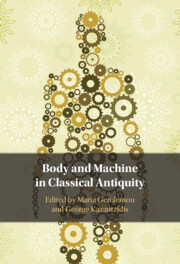Book contents
- Body and Machine in Classical Antiquity
- Body and Machine in Classical Antiquity
- Copyright page
- Contents
- Figures
- Contributors
- An Introduction to Body–Machine Intersections
- Part I Blended Bodies
- Part II The Technological Body
- Part III Towards the Mechanization of the Human Body
- Chapter 7 Aristotle on the Lung and the Bellows–Lungs Analogy
- Chapter 8 The Ill Effect of South Winds on the Joints in the Human Body
- Chapter 9 The Beauty That Lies Within
- Chapter 10 The Mechanics of the Heart in Antiquity
- Chapter 11 The Mechanics of Galen’s Theory of Nutrition
- Chapter 12 Iatromechanism and Antiquarianism in Morgagni’s Studies on Celsus, 1720–1761
- Conclusions or From Antiquity to the Early Modern
- Index of Passages
- General Index
- References
Chapter 10 - The Mechanics of the Heart in Antiquity
from Part III - Towards the Mechanization of the Human Body
Published online by Cambridge University Press: 13 July 2023
- Body and Machine in Classical Antiquity
- Body and Machine in Classical Antiquity
- Copyright page
- Contents
- Figures
- Contributors
- An Introduction to Body–Machine Intersections
- Part I Blended Bodies
- Part II The Technological Body
- Part III Towards the Mechanization of the Human Body
- Chapter 7 Aristotle on the Lung and the Bellows–Lungs Analogy
- Chapter 8 The Ill Effect of South Winds on the Joints in the Human Body
- Chapter 9 The Beauty That Lies Within
- Chapter 10 The Mechanics of the Heart in Antiquity
- Chapter 11 The Mechanics of Galen’s Theory of Nutrition
- Chapter 12 Iatromechanism and Antiquarianism in Morgagni’s Studies on Celsus, 1720–1761
- Conclusions or From Antiquity to the Early Modern
- Index of Passages
- General Index
- References
Summary
In several works and passages, Galen reports on the model of the heart as developed by Erasistratus. Already in 1995 (published in 1997), Heinrich von Staden pointed to the parallel between Erasistratus’ model and the force pump. This technical device, which belongs to the technical apparatus developed in the frame of ancient water-supply systems, was indeed codified in textual and probably even diagrammatic form for the first time by the contemporary Ctesibius during the third century. This chapter first revisits Galen’s reports to define Erasistratus’ model of the heart technically and precisely. Subsequently, it analyzes a series of ancient works and fragments from the Hellenistic period until the second century to establish the extent to which such parallelisms are historically justified on the level of the scientific reflections of the time. In the background, the analysis of archeological findings of periods are considered to show that, contrary to what is usually assumed, the realm of practical activities and engineering might have been strongly influenced by the anatomic knowledge of antiquity.
- Type
- Chapter
- Information
- Body and Machine in Classical Antiquity , pp. 245 - 261Publisher: Cambridge University PressPrint publication year: 2023



